|
|
|
Personal
Interests - Travelling to Istanbul
|
| |
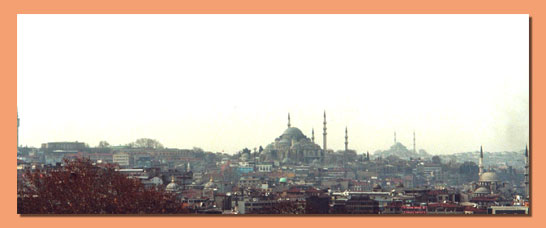 |
| |
|
It really is not so easy to find a proper
way to start saying some things about Istanbul. The city
is unique, magnificent and vivid and leaves you speechless
on your first visit. It may be its thousands over thousands
years of history and the greatness of lost empires, it may
be the aura of having being the "center of the world"
for so many centuries, it may be its geographical location
between seas and continents, it may be all the previous
together...The reasons to visit Istanbul are so many and
so obvious, that it's really needless to argue about. Just
jump at any chance to visit it. Istanbul is a city that
you can't miss, if you're a real traveler.
|
| |
|
Tell me a few things about the history
of the city...
|
| |
|
The ancient name of the city was Byzantio
(Byzas - a Greek Megarian colony seeker - founded the first
city there around 7th century B.C.), but the Roman Emperor
Constantine the Great, decided to move there the capital
of the Roman Empire in 306 A.D. - a move that actually started
the period of the Byzantine Empire. For more than 1.100
years, the city (under the name "Constantinople"
or just "Polis", the Greek word for The City)
was the capital of this great Empire. Every Emperor was
trying to leave something behind under his name (except
of course intrigues, conspiracies, inter-family assassinations,
etc), but the one who really overdid it was Emperor Iustinianus
I, who actually rebuilt the whole center of the city, which
was destroyed after the Nikas Revolt. Among other things,
he built the unbelievable Hagia
Sofia Church (Sancta Sofia or Aya Sofia), which is the
indisputable architectural milestone of the city and the
magnificent underground Basilica
Cistern. The following centuries, the city was repeatedly
attack by Arabs, Slavic nomads, Persians and generally everybody
else in the area, who felt confident enough to try his luck.
Crusaders finally made it and conquered the City in 1204,
but they last only some years before the clans of Byzantine
Emperors took over the capital. But the downfall of Byzantine
Empire had already begun.
In 29th May 1453, Ottoman Turk Sultan
Mehmet II the Conqueror, entered the City after a 53 days
siege and a furious but hopeless resistance by the last
Byzantine Emperor, Konstantinos Palaiologos, and what had
remained of his army. A new era of greatness started for
the city, this time as the capital of Ottoman Empire. The
famous architects Sinan and Balyan (in different periods
each one) left their marks on the city. The peak of Ottoman
Empire was the so-called "Tulip Era" - obvious
sign of this period is the Topkapi Palace.
During 19th century, the city started
to expand and follow modern architect designs. National
hero Mustafa Kemal Ataturk is another great personality
in Turkish history - maybe it's the person who's most responsible
for any modern and "western" element Turkey has
until now. Istanbul was occupied by alliance troops during
World War I. Ataturk, leading a resistance movement on the
east part of the country, established with the help of army,
the new Turkish Republic as a secular state, leaving out
of the new constitution the "Islamic religion state"
thing. In 1923, after Ataturk's success, all the foreign
troops left Istanbul, but the capital of the newly born
Democracy was proclaimed Ankara.
|
| |
|
I'm not sure that I can figure out
completely the map of Istanbul ...can you help me?
|
| |
|
Well...things are little complicated indeed.
Istanbul is built on the two sides of the very strategically
crucial Bosphorus channel, with the northern part ending
into the Black Sea and the southern part into the Marmara
Sea. Generally the city is divided in three parts: the old
city, the new city and the Asiatic side. Old city and New
city (which generally are the biggest part of the city)
are located in the European side.
If you take a thorough look on the city's
map, you will notice on the left part on the heart of
the city an inlet of the Bosphorus. This inlet is a natural
7 km channel named Golden Horn. Golden Horn separates Old
from New City. There are two bridges over Golden Horn connecting
the Old and the New part of the city: the Galata Bridge
and the Ataturk Bridge.
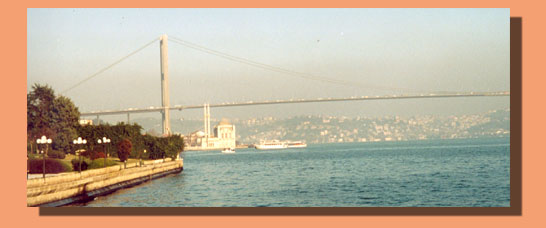
The European and the Asiatic sides of the city are connected
with two other (very impressive indeed) bridges: the Bosphorus
Bridge - one of the world's longest suspension bridges -
and Fatih Sultan Mehmet Bridge.
In the Sea of Marmara, there are nine islands called Prigiponissia
(Princess Islands in Greek, because they were the Emperor's
favorite place to exile the Byzantine Princes).
Today the city's inhabitants amount to
about 12 million. The unquestionable center of the city
is Taksim Square in the Beyoglu area in the New part, but
the area where the most historical monuments are located
is Sultanahmet, on the Old part. Anyway, you have to keep
in mind that the city is quite large, that there are many
commercial centers and many worth-seeing monuments spread
all around the broad Istanbul limits. It would not take
less than a week of everyday tours to visit the whole of
Istanbul, although an active program of 3-4 days would most
likely satisfy you.
|
| |
|
Can you give me a shortlist of monuments
that I definitely have to visit in Istanbul?
|
| |
|
This is really a hard task...There are
so many historical places in Istanbul you have to see, that
is quite difficult to decide which of them you should leave
out, if your visit is under time pressure. I have tried
here to select the not-to-be-missed monuments, to my mind.
First one is easy...Hagia
Sofia (or Aya Sofia or Sancta Sofia). For almost a thousand
years Aya Sofia was the largest enclosed space in the world.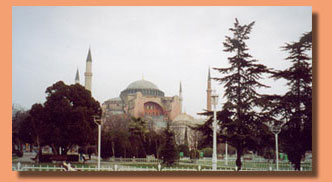 After
the Nikas Revolt the city center (including the St. Sophia
church constructed originally by Emperor Konstantine I was
completely destroyed. Emperor Iustinianus I decided to supervise
personally the genius architects Anthemios
and Isidoros and construct a new, bigger church, on
the same spot. The huge building completed in the record-time
of 5 years, in 537 A.D. Marbles, stones, columns and everything
else was imported from Anatolian ancient cities and the
luxury of the church was breathtaking. But the thing that
was leaving speechless all the foreign visitors of the church
(and still does) is the dome: 55 m high and 30 m diameter,
with no immediate column supporting, makes you think that
really is a whole universe "flying" over your
head. For the time that the monument was constructed, this
achievement was almost a miracle. Byzantines (who were really
bound to make myths about everything...) used to say that
God himself gave the Aya Sofia design, through an Angel
to Emperor Iustinianus. Anyway, Aya Sofia monument is still
one of most important architectural monuments of the world.
The feeling when you're standing right in the middle of
the central section under the dome is one: awe. For more
than 400 years Aya Sofia was a mosque. Sultan Mehmet II
the Conqueror immediately turned the Orthodox Christian
Church into a mosque on the very same day that he invaded
the city and during the centuries many of its unbelievable
mosaics and wall-paintings were miserably covered by plaster
while some others were completely destroyed by added Islamic
ornamentation. Since 1935 it has been functioning simply
as a museum. After
the Nikas Revolt the city center (including the St. Sophia
church constructed originally by Emperor Konstantine I was
completely destroyed. Emperor Iustinianus I decided to supervise
personally the genius architects Anthemios
and Isidoros and construct a new, bigger church, on
the same spot. The huge building completed in the record-time
of 5 years, in 537 A.D. Marbles, stones, columns and everything
else was imported from Anatolian ancient cities and the
luxury of the church was breathtaking. But the thing that
was leaving speechless all the foreign visitors of the church
(and still does) is the dome: 55 m high and 30 m diameter,
with no immediate column supporting, makes you think that
really is a whole universe "flying" over your
head. For the time that the monument was constructed, this
achievement was almost a miracle. Byzantines (who were really
bound to make myths about everything...) used to say that
God himself gave the Aya Sofia design, through an Angel
to Emperor Iustinianus. Anyway, Aya Sofia monument is still
one of most important architectural monuments of the world.
The feeling when you're standing right in the middle of
the central section under the dome is one: awe. For more
than 400 years Aya Sofia was a mosque. Sultan Mehmet II
the Conqueror immediately turned the Orthodox Christian
Church into a mosque on the very same day that he invaded
the city and during the centuries many of its unbelievable
mosaics and wall-paintings were miserably covered by plaster
while some others were completely destroyed by added Islamic
ornamentation. Since 1935 it has been functioning simply
as a museum.
I think that the second one is easy too...Blue
Mosque, just opposite Aya Sofia. Ok, you don't have
to be genius to realize a) what was the purpose of
building that mosque in this particular point and b)
what was the pattern for designing the mosque: Sultan Ahmet
I, wanted to build a mosque bigger and more spectacular
than Iustinianian Aya Sofia. And his architect Mehmet Aga,
made a really good effort to imitate it. They came that
close...but it's obvious that finally they didn't achieve
their goal. Blue Mosque (which was built over 1000 years
after Aya Sofia), stands there luxurious lightened, perfectly
preserved, with an obvious agony to compete Aya Sofia, but
in the end it's just an excellent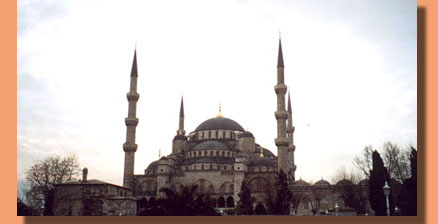 but
easily forgotten monument, comparing to unbeatable architectural
masterpiece of Emperor Iustinian, no matter how damaged
looks outside and truly is, inside. Lonely
Planet's guide about Istanbul has a succinct remark
about Blue Mosque: "Its architect Mehmet Aga, achieves
the sort of visual experience on the exterior that Aya Sofia
has on the interior". And that's absolutely true,
if you stand in the middle of the distance between the two
buildings and try to compare their size just by the look.
Blue Mosque gives the impression that is bigger than Aya
Sofia. But if you check the interiors of the two monuments,
you will realize at first glance, that Mehmet Aga couldn't
avoid four massive columns to support Blue Mosque's smaller
and obvious less impressive than Aya Sofia's dome. Anyway,
Blue Mosque is a definitely worth-seeing monument in Istanbul,
a perfect example of classic Ottoman design. Notice that
the mosque is not a kind of museum like Aya Sofia, but still
works as a sacred Muslim place for worshipers - so check
out the visiting hours, because tourist are not allowed
during the praying times. And of course don't forget that
you will have to take your shoes off before entrance... but
easily forgotten monument, comparing to unbeatable architectural
masterpiece of Emperor Iustinian, no matter how damaged
looks outside and truly is, inside. Lonely
Planet's guide about Istanbul has a succinct remark
about Blue Mosque: "Its architect Mehmet Aga, achieves
the sort of visual experience on the exterior that Aya Sofia
has on the interior". And that's absolutely true,
if you stand in the middle of the distance between the two
buildings and try to compare their size just by the look.
Blue Mosque gives the impression that is bigger than Aya
Sofia. But if you check the interiors of the two monuments,
you will realize at first glance, that Mehmet Aga couldn't
avoid four massive columns to support Blue Mosque's smaller
and obvious less impressive than Aya Sofia's dome. Anyway,
Blue Mosque is a definitely worth-seeing monument in Istanbul,
a perfect example of classic Ottoman design. Notice that
the mosque is not a kind of museum like Aya Sofia, but still
works as a sacred Muslim place for worshipers - so check
out the visiting hours, because tourist are not allowed
during the praying times. And of course don't forget that
you will have to take your shoes off before entrance...
In the same Sultanahmet area, I think
that the third choice of must-seeing monuments, is quiet
easy too...Topkapi
Palace. Topkapi was first build by Mehmet the Conqueror
himself, and was the resident and headquarters for all the
Sultans until 1839. After it's last resident Sultan Mahmut
II, Sultans preferred to stay to other more European style
Palaces like Dolmabahce or Ciragan. It's really difficult
to describe Topkapi Palace...it's massive, it's "painfully"
arabesque some times for "western" eyes and it's
really impressive. Of course you should not miss visiting
in there the Harem
(to learn how was the Sultan's family everyday life), the
recently renovated Imperial Treasury (to see among other
items the famous diamonds of the Jules Dassin's "Topkapi"
movie with Peter Ustinov and Melina Merkuri) and the Sacred
Safekeeping Rooms (to see hairs from Prophet Mohammed's
beard, Prophet Mohammed's tooth and other remains of him,
Caliph Omar's - and of course Prophet Mohammed's too - swords,
even the Mose's walking baton). You will definitely need
3 to 5 hours just for a quick visit to Topkapi Palace, so
be prepared...
Speaking of Sultan's Palaces, Dolmabahce
Palace is really another worth-seeing place in Istanbul.
Dolmabahce was built when the decline of the Ottoman Empire
had already started. That's why some points of the Palace
are "too much": the impression of greatness and
power had to be given at any cost, while the same time the
whole Ottoman Empire's wealth was under European banks control.
Dolmabahce is a mixture of Ottoman and European Baroque
design style...it's something that you have to see your
own eyes to decide if you like or not. For my taste, I think
it's exactly the opposite of what I like...
The same architect (Balyan) is responsible
for the other worth-seeing Palace, almost 1 km further than
Dolmabahce, the famous Ciragan Sarayi. Well...it seemed
that after a point, every Sultan wanted to built his own
Palace to stay, using the old ones as home-prisons for his
annoying relatives (let's say for other legitimate claimers
of the Sultan throne...). 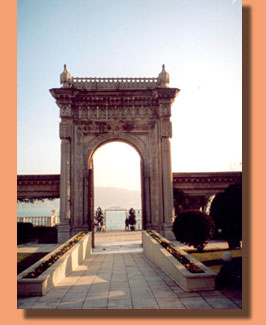 Ciragan
- comparing to Dolmabahce - is less ambitious and more modest,
but in a strange way is more imposing. Ciragan now is hotel,
belonging to Kempinski Hotels company, under the full name
"Ciragan
Palace Hotel Kempinski Istanbul". If you are not
Bill Gates or an equally wealthy person, think twice before
booking a room there, but if you are just a quiet properly
dressed average traveler, it's a good idea to reward yourself
with a coffee at the Ciragan's Gazebo and take a walk to
the magnificent lobby and the pool deck on Bosphorus side. Ciragan
- comparing to Dolmabahce - is less ambitious and more modest,
but in a strange way is more imposing. Ciragan now is hotel,
belonging to Kempinski Hotels company, under the full name
"Ciragan
Palace Hotel Kempinski Istanbul". If you are not
Bill Gates or an equally wealthy person, think twice before
booking a room there, but if you are just a quiet properly
dressed average traveler, it's a good idea to reward yourself
with a coffee at the Ciragan's Gazebo and take a walk to
the magnificent lobby and the pool deck on Bosphorus side.
My last suggestion about must-seeing monuments
is back on Sultanahmet area: the Basilica
Cistern. An imposing, atmospheric, unforgettable place.
Another masterpiece of Emperor's Iustinian, the Cistern
contained 80.000 cubic meters of water and it was made for
supporting the city when it was under siege. The roof stands
upon 336 huge columns and is 70 m wide and 140 m long. The
Istanbul Municipality cleaned, renovated, made walkways
and lit in a wonderful way the Cistern. You can find also
a cafe and if you are lucky, enough maybe a classic music
concert will be held there during your visit. Don't miss
this experience.
Of course these are just few places that I suggest, but
really are like one drop in the ocean, considering the size
of the city and the number of monuments. Truth is that to
be able to say that you covered the basic monuments of Istanbul,
you will definitely need at least 1 week.
|
| |
|
Tell me few things about the social
and political situation in Istanbul and Turkey...
|
| |
|
I could say that things are rather complicated...Of
course I'm not in position to speak about the whole country,
because I've seen only Istanbul, but I can guess a few things
about the rest. Turkey is in a huge dilemma: two, equally
strong, cultural traditions are struggling for the future
of the country. First the "eastern" Muslim and
more religious tradition has really powerful roots all over
the country but mostly in rural areas and the "deep"
eastern part of the country. Second the "western"
and more secular tradition tries to lead the country into
western social patterns and is mostly evident in the big
urban centers on the west part of the country and the capital
as well.
The current government with Prime Minister
Rejep Tayip Erdogan, typically originates from the "hardcore"
Muslim party, but the truth is that they distanced themselves
from this pole and they can be said to be trying hard to
keep the balance between the two traditions. I think that
the definitive characteristic element of this "war
of the worlds" that is taking place in Turkey is the
female Muslim headscarf, although it might be nothing more
than a symbol. While in Istanbul you can see women dressed
with headscarves and long black dresses walking next to
girls dressed like Jennifer Lopez or Beyonce Knowles.
A major quest of
Turkey for the years ahead, is to become a full member of
the European Union. Another unquestionable thing is that
Turkey needs some changes in order to be a proper democratic
country - at least in terms of the European meaning of the
word. It is common knowledge that underneath the "surface"
of democratic procedures (parties, elections, etc) the true
governing power is the army. Every political decision MUST
have the approval of a powerful, army-controlled committee
that is called National Security Council. But wait...things
are a bit more complicated than that...don't be in a hurry
to contempt the army, because it seems to be the strongest
factor, which guarantees the secular character of the state.
You could say that, in a way it is the balancing power between
the strong Islamic-oriented political trends and the "western-type"
reforming powers. One must not underestimate these Islamic-oriented
trends: Erdogan's government (although a modest one) is
an Islamic government and its political roots lie in the
almost fundamentalist Muslim party of (now accused and being
one step before the jail) Necmettin Erbakan. Erbakan, leader
of Refah political party, had won the 1996 elections (which
means by the Turkish election system, that just took the
higher percentage than the rest: 23%), but after some visits
to Iran and to some other "beyond the limits"
Islamic countries, it was just a matter of time for the
National Security Council to find a quick way to through
him out. Erdogan was the very successful Istanbul's mayor,
coming from Erdogan's party. But Erdogan really learned
the lesson: he gave all the necessary promises to the army,
took his distance from Erbakan's hardcore political thesis
and committed to the European perspective for the country.
He still governs...
In November 2003
three bomb blasts took place in Istanbul killing many people
over a two weeks period: one in Neve Shalom Synagogue, another
in British Consulate and the last one in the building of
HSBC Bank. 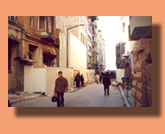 All
these spots are very central - a thought that makes these
terrorist actions even scarier. This photo on the left,
is the Neve Shalom Synagogue street, after the terrorist
attacks on November 2003. Anyway, the question still remains:
who did it? The easy answer is to say "of course the
Islamic fundamentalists, to make the long story short: Bin
Laden", but many people in Turkey will disagree, as
I conclude after many conversations I had there with Turkish
friends of mine. I don't really want to get into a vicious
circle of speculation and rumors, but I just have to say
that in so complicated situations like this one, don't necessarily
believe what seems to be obvious... All
these spots are very central - a thought that makes these
terrorist actions even scarier. This photo on the left,
is the Neve Shalom Synagogue street, after the terrorist
attacks on November 2003. Anyway, the question still remains:
who did it? The easy answer is to say "of course the
Islamic fundamentalists, to make the long story short: Bin
Laden", but many people in Turkey will disagree, as
I conclude after many conversations I had there with Turkish
friends of mine. I don't really want to get into a vicious
circle of speculation and rumors, but I just have to say
that in so complicated situations like this one, don't necessarily
believe what seems to be obvious...
|
| |
|
In summary, what is the "15
Things to Do" in Istanbul?
|
| |
|
1) (Of course) visit Aya Sofia.
I would suggest generally starting your tour around the
city from there. Go to the second level to the point where
the Empress and her followers were attending the Sunday
ceremony and imagine that you are Theodora. Go stand in
the middle of the main hall, just underneath of the center
of the dome and look up. That should be enough...
2) Go to the Blue Mosque, just
opposite of Aya Sofia. Compare the two monuments (inevitably)
and watch carefully the way the dome tries to be bigger
than Aya Sofia's, but doesn't make it. Sit silent in a corner
an try to get in the mood of the people who are praying
the same time, no matter if you're a Muslim or not. You
can find your "divine feeling" everywhere.
3) Start early in the morning your
visit to Top Kapi. You will need 4-5 hours just for a quick
look. Harem and Treasury are the highlights and if you are
a Muslim, the room with the Prophet Mohammed's relics will
be of special importance to you. I have also to make a special
reference to the section with the Sultans clothes. Some
of them are really wonderful and you will get surprised
how updated are some of the designs - like haute couture
by Kenzo or Miyake. Of course don't forget to see the spectacular
view from Baghdad Gazebo, trying to imagine you as a Sultan
(don't know exactly if this is good or bad, but in any case
watch your back!).
4) Where to stay? Istanbul has
really thousands and thousands of hotels for every mood,
budget or preference. But generally you will have to make
a choice by location: if you want to be in a more quite
setting and closer to main monuments, you will have definitely
to stay to Sultanahmet area, if you want to be closer to
the city-center you will have to stay to Beyoglu area and
if you want something more picturesque and a bit more out
of the way go to Ortakoy area. If money is no problem for
you (first of all, please make a donation to the writer
and then) try "Four
Seasons Hotel", "Ciragan Palace Hotel Kempinski
Istanbul" or "Swiss Hotel". If money is a
concern, though, try one of the small "boutique hotels"
in the Sultanagmet area. There is no meaning to mention
some names because there are innumerous of them, all in
same good quality level of services and moderate prices.
5) Staying or not at these hotels,
really worth a visit there just to have a coffee: at "Ciragan
Palace Hotel Kempinski Istanbul" find a nice table
near the window at Gazebo in the afternoon at let your eyes
travel to Bosphorus waters watching all the kinds of ships
passing by and to the 17th floor of Executive Lounge of
"Swiss
Hotel" you will get the best view of the city can
get. Beautiful!!
6) What??!! Are you planning to
leave Istanbul without first visiting a hamam? Big mistake!
There's a whole special procedure in hamam baths that makes
them an experience you can't afford to miss. First, you'll
be given a private booth to leave your clothes and personal
belongings. Then, with only a towel round your hips, you
will be entering a steam room for some hour(s). After this
first step everything depends on your choice, but the full
"program" goes like this: About the time you start
to literally melt away and wondering how much time you have
till you drop dead suffocating, your personal masseur /
bather takes you to a wide hall, less steamy but hot as
well. Then starts to massage you and relax your body - or
whatever left of it after the steam bath. Then, the masseur
takes a special loaf and soap and starts rubbing you. You
will get surprised and embarrassed of the dirt that comes
out of your skin. It's a crucial hit to your western-hygiene
culture. Ok, it's not exactly dirt (supposing that you're
having bath regularly) but the upper level of your skin
- something like vicious peeling all over. After this, a
hot water showering is taking place and then...you're ready
to collapse. You can do it inside the hamam, you can have
a tea or a coffee or a sleep for some time. You will feel
as relaxed and clean as it gets. Generally there are different
sections for men and women and the whole thing - apart from
bathing and steaming - is a place for socializing. There
are local and more tourist-oriented hamams. The two most
famous hamams in Istanbul is "Cagaloglu
Hamam" and "Cemberlitas".
The first one is the oldest hamam in Istanbul with a magnificent
central hall, where some scenes of Indiana Jones were shoot
years ago. Wherever you choose, hamam is a "must to
do" in Istanbul.
7) Visit the Basilica
Iustinian Cistern at Sultanahmed area. If there's a
concert or an exhibition there don't miss it.
8) Visit Galata Tower. The views
from up there are stupendous and you can watch the panorama
all around the tower. There is also a restaurant at the
same top level of the tower, but don't expect to have view
while you're sitting in a table, because other tourists
are hanging around on the narrow cylindrical corridor of
the tower and the only thing that you can see from the tables
is their backs.
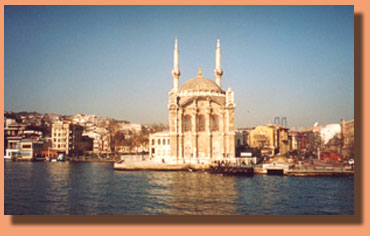 9)
Saturday and Sunday do go to Ortakoy market. The whole area
has a very vivid and bohemian spirit, with thousands of
cafes, open markets, jacked potato stands, loud music and
all these, just beneath the spectacular Bosphorus Bridge. 9)
Saturday and Sunday do go to Ortakoy market. The whole area
has a very vivid and bohemian spirit, with thousands of
cafes, open markets, jacked potato stands, loud music and
all these, just beneath the spectacular Bosphorus Bridge.
10) Try to attend a Whirling Dervishes
show. It should be easy as they are performing regularly
in different places around the city. Of course, it is hardly
possible to find authentic Sufi Mevlana followers or even
somethingnear Whirling Dervishes but not too tourist-oriented
show. A quiet decent proposal is the Festival of "Sufi
Music & Ritual" by the group of "Contemporary
Lovers of mevlana" on the Exhibition Hall of the Railway
Station on Eminonu area. Note that the Exhibition Hall,
is the old and very impressive last station of the legendary
Orient Express - so one way or the other worth's a visit
there.
11) For your night walks, of course
go to Taksim area. The main road (that you have walk at
least 20 times from one end to the other as everybody does)
is Istiklal Cadesi ("Cadesi" means "Road").
You can say that Istiklal is the heart of the modern commercial
center of the city. Everything is here: fancy clothes, traditional
restaurants, hotels, clubs, live music pubs, fast foods,
music and book stores, street artists, everything...just
take your pick. In Istiklal you can see one of the oldest
trams in the world still going its route from Taksim to
Tunel and reverse.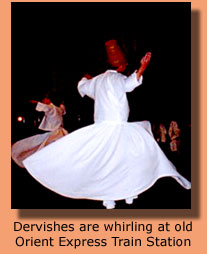 Try
all the narrow roads left and right of Istiklal and look
up: the best places usually are located in one of the floors
on the buildings. Going down from Taksim to Tunel, on your
right there's Navizade area - a small road with fresh fish
stores and street restaurants with fried seafood. Of course
try everything you see. Try
all the narrow roads left and right of Istiklal and look
up: the best places usually are located in one of the floors
on the buildings. Going down from Taksim to Tunel, on your
right there's Navizade area - a small road with fresh fish
stores and street restaurants with fried seafood. Of course
try everything you see.
12) Try to find on Taksim area
on of the best lounge bar restaurants in Istanbul, the "5
Kat" (meaning "5th Floor"). It's in the
area behind Taksim Square and really worth's a visit. The
view from the terrace is superb and the decoration inside
is very elegant. The place belongs to a famous Turkish actress
Mrs. Yasemin Alkaya. Prices are not very low but the food,
the whole environment and the people working there, worth
the money that you'll pay. Try one of the barman's cocktails,
like Mohito!
13) One of the best alternative
and coziest clubs in Istanbul is Babylon.
Babylon hosts international performances. Mostly the music
is world, electronica and jazz but everything goes in Babylon.
The club is decorated in a very cozy way and "feels
like home" immediately. Definitely worth a visit in
a night-out tour.
14) What to say about the Turkish
cuisine and pastry...maybe I'm not the most objective source
to comment, because - as Greek - our cuisine is similar
in many points. Turkish cuisine is spicy, not spicy-hot
(as Thai is) but heavy spicy in a more oriental way. But
the one thing you have to pay special attention in Istanbul
is the pastry: if you're a syrup lover, then you'll find
your paradise here. Don't forget to try also the famous
"Turkish Delights" (try the best in town from
Haci Bekir in Istiklal). Anyway, as it is obvious Istanbul
is not a proper place to start a diet.
15) Take the 3+ hours tour to Bosphorus
to appreciate the grandeur of the city. You can do it in
many ways. There are state cruise ships or smaller private
ships and boats. Be sure to reach Anadolu Kavagi, a small
fishermen's village on the north of Bosphorus, with a well
preserved castle heading to open horizon of the Black Sea.
Just climb up there at take a look at the north horizon...
|
| |
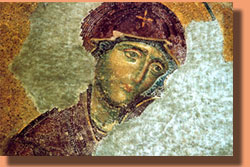 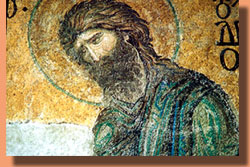 |
| |
|
|
| |
|
|
|
|

